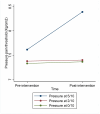CPM-Related Mechanisms Could Play a Key Role in the Effects on Pain Sensitivity Induced by Manual Therapy: Three Crossover Trials Investigating the Effects of Manual Pressure
- PMID: 38999214
- PMCID: PMC11242484
- DOI: 10.3390/jcm13133648
CPM-Related Mechanisms Could Play a Key Role in the Effects on Pain Sensitivity Induced by Manual Therapy: Three Crossover Trials Investigating the Effects of Manual Pressure
Abstract
Objective: The aim of this study is to assess whether pain-inducing manual pressure (PIMP) leads to effects on pressure pain threshold (PPT) mediated by conditioned pain modulation (CPM) and whether these effects are influenced by the intensity and repetition of the stimulus. Additionally, the influence of psychological factors and physical activity on the response to PIMP was explored. Methods: A total of 72 pain-free students were randomly assigned to three crossover trials. Trial 1 compared the effects of PIMP with the cold pressor task and pain-inducing electrostimulation. Trial 2 compared the effects of manual pressure that elicited moderate pain, mild pain, and no pain. Trial 3 compared a single PIMP stimulation with four stimuli applied at the same site or at different sites. Results: PIMP produced a lower increase in PPT than cold pressor task and no difference with electrostimulation. Manual pressure that caused moderate pain led to a greater increase in PPT compared to mild pain and pain-free application. Repetition of PIMP stimulus, whether at the same or different sites, did not significantly increase PPT compared to a single stimulation. No association with psychological factors or physical activity was found. Conclusions: PIMP produces an increase in PPT, suggesting the involvement of CPM-related mechanisms.
Keywords: conditioned pain modulation; manual therapy; pain mechanisms.
Conflict of interest statement
The authors declare no conflicts of interest.
Figures
Similar articles
-
Reliability of the conditioned pain modulation paradigm across three anatomical sites.Scand J Pain. 2020 Apr 28;20(2):283-296. doi: 10.1515/sjpain-2019-0080. Scand J Pain. 2020. PMID: 31812949
-
Exercise induced hypoalgesia during different intensities of a dynamic resistance exercise: A randomized controlled trial.PLoS One. 2024 Apr 16;19(4):e0299481. doi: 10.1371/journal.pone.0299481. eCollection 2024. PLoS One. 2024. PMID: 38625975 Free PMC article. Clinical Trial.
-
A psychophysical study comparing massage to conditioned pain modulation: A single blind randomized controlled trial in healthy participants.J Bodyw Mov Ther. 2021 Jul;27:426-435. doi: 10.1016/j.jbmt.2021.02.014. Epub 2021 Mar 6. J Bodyw Mov Ther. 2021. PMID: 34391267 Clinical Trial.
-
Enhanced Pronociceptive and Disrupted Antinociceptive Mechanisms in Nonspecific Chronic Neck Pain.Phys Ther. 2021 Mar 3;101(3):pzaa223. doi: 10.1093/ptj/pzaa223. Phys Ther. 2021. PMID: 33351923
-
Transcutaneous electrical nerve stimulation and conditioned pain modulation influence the perception of pain in humans.Eur J Pain. 2013 Nov;17(10):1539-46. doi: 10.1002/j.1532-2149.2013.00328.x. Epub 2013 May 6. Eur J Pain. 2013. PMID: 23650092 Free PMC article. Clinical Trial.
Cited by
-
Conditioned pain modulation elicited through manual pressure techniques on the cervical spine: a crossover study.Pain Rep. 2025 Mar 18;10(2):e1258. doi: 10.1097/PR9.0000000000001258. eCollection 2025 Apr. Pain Rep. 2025. PMID: 40109370 Free PMC article.
References
LinkOut - more resources
Full Text Sources






